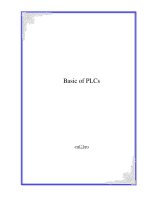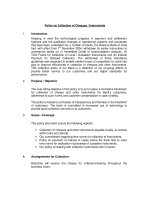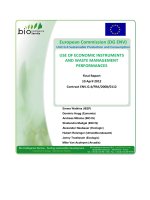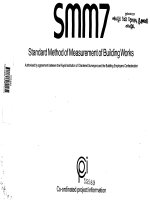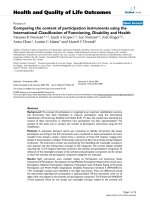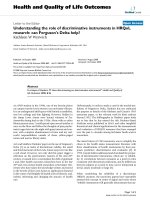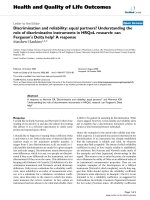Basic of measurement instruments
Bạn đang xem bản rút gọn của tài liệu. Xem và tải ngay bản đầy đủ của tài liệu tại đây (1.48 MB, 28 trang )
<span class="text_page_counter">Trang 1</span><div class="page_container" data-page="1">
Basics of
Measurement Instruments
<small>1</small>
</div><span class="text_page_counter">Trang 3</span><div class="page_container" data-page="3">- Beta ratio (orifice Dia to pipe ID) should be between 0.3 & 0.7
- Typical permanent pressure loss = 0.7 of DP at normal flow
- Straight lengths is important consideration. If not possible, flow straighteners should be provided.
- Recommended installation is on horizontal lines. If on vertical lines it is preferred to have flow from bottom to top.
- Taps for liquids from bottom half of tap & for gases from top half of pipe.
- Flange location - Tap location 1 inch upstream and 1 inch downstream from face of orifice. Most commonly used.
- Radius taps – 1 pipe diameter (D) upstream & 0.5D downstream from orifice plate.
- Corner taps--taps located at the face of the orifice plate. Normally used in the line sizes smaller than 2".
- Pipe taps – 2.5 pipe diameter (D) upstream & 8D downstream from orifice plate.
</div><span class="text_page_counter">Trang 4</span><div class="page_container" data-page="4">*Flow element is introduced in the flow path to produce a DP. This can be orifice plate, venturi, flow nozzle etc
*Based on Bernoulli’s theorem, flow rate is
proportional to the square root of DP.
*This DP is measured by a DP transmitter that is
extracts the square root & is calibrated to flow units.
Head meters Principle
Bernoulli’s theorem
In a fluid stream the sum of pressure head, velocity head & elevation head at a point is equal to their sum at any other point in the direction of flow plus the losses due to friction between these two
points”
</div><span class="text_page_counter">Trang 5</span><div class="page_container" data-page="5">-Rotameters (also known as variable-area
flowmeters) are typically made from a tapered glass tube that is positioned vertically in the fluid flow.
-A float that is the same size as the base of the glass tube rides upward in relation to the amount of flow. Because the tube is larger in diameter at the top of the glass than at the bottom, the float resides at the point where the differential
pressure between the upper and lower surfaces balance the weight of the float.
-Variations : Glass tube & Metal tube
-A measuring scale is provided as a reference & the position of the float is measured off against this scale
- Can be equipped with switch contacts & transmitters.
Rotameter
</div><span class="text_page_counter">Trang 6</span><div class="page_container" data-page="6">instrument, amplified & indicated as flow*Min fluid conductivity : 20uS/cm. Special 5uS/cm.
*Line to be full. Special instruments for partially filled lines.
</div><span class="text_page_counter">Trang 7</span><div class="page_container" data-page="7">Acoustic signal (ultrasonic) is transmitted from one sensor to the other.
If sent in the direction of flow, the signal will be received earlier. If sent against the direction of flow, the signal will be received later. In effect the resultant time difference is directly
proportional to the flow rate.
This time difference is used as an indication of the flow rate.
Ultrasonic
</div><span class="text_page_counter">Trang 8</span><div class="page_container" data-page="8">Doppler effect
When wave energy like sound or radio waves travels from two objects, the wavelength can seem to be changed if one or both of them are moving. This is called the Doppler effect.
Particles in fluid stream which is moving cause the frequency shift between the transmitted signal & received signal. This frequency shift indicates the actual flow rate.
Ultrasonic
</div><span class="text_page_counter">Trang 9</span><div class="page_container" data-page="9">Vortex flowmeter – Von Karman effectwhen a non-streamlined object (bluff body) is placed in the path of a fast-flowing stream, the fluid will alternately separate & form vortices from the object on its two downstream sides.Vortex shedding frequency is directly
proportional to the velocity of the fluid in the pipe, and therefore to volumetric flow rate.
The shedding frequency is independent of fluid properties such as density, viscosity,
conductivity, etc., except that the flow must be turbulent for vortex shedding
Nowadays the vortex is sensed using pressure sensing by piezoresistive or capacitive sensors.
Vortex
</div><span class="text_page_counter">Trang 10</span><div class="page_container" data-page="10">B). Switches1)Float
2)Displacer3Ultrasonic etcC). Transmitters
1)DP type2)Ultrasonic3)Radar
4)Displacer5)Capacitance
</div><span class="text_page_counter">Trang 11</span><div class="page_container" data-page="11">Level measurement
Flat glass gauges Transparent type
Reflex type<small>Transparent gages have a vision slot on both sides of the chamber. Light enters the gage from the side opposite the observer so that both the level of a liquid and its characteristics can be seen. For easier liquid observation in dark </small>
<small>environments, illuminators are available for use with transparent gauges.</small>
<small>*Reflex gages have a single vision slot in which light can enter the gage chamber to determine liquid level.</small>
<small>*Light striking the area of glass covered by transparent liquid is allowed to pass through to the interior of the gage along the entire length of the covered prism. The light is reflected from the back of the chamber to the observer. Typically the chamber appears dark.</small>
<small>*Light striking the area of the glass above the liquid level is reflected instead of passing through to the back of the chamber. This produces a silver appearance in the glass. The liquid level in the chamber is </small>
<small>represented where the silver and dark/opaque area meet.</small>
</div><span class="text_page_counter">Trang 12</span><div class="page_container" data-page="12">Level gauges
Tubular gauge glass<sub>Magnetic gauge glass</sub><sub>Flat glass gauges</sub>
</div><span class="text_page_counter">Trang 13</span><div class="page_container" data-page="13">Level measurement - Switches
<small>Float type</small>
<small>Floats on fluid surface</small>
<small>Displacer type– Up to 4 points.– Different materials</small>
<small>•Liquid level movement changes the buoyancy force on a displacer suspended from a range spring. The force change on the spring causes it to expand or contract moving an attraction sleeve into or out of the field of the switch magnet, actuating the switch.</small>
</div><span class="text_page_counter">Trang 14</span><div class="page_container" data-page="14">Level Transmitters
<small>Differential pressure type</small>
<small>•Uses a DPT to measure the pressure at the bottom of the tank</small>
<small>•If tank is atmospheric, the low side of transmitter is open to atmosphere</small>
<small>•If tank is pressurised, the low side of transmitter is connected to the top of the tank</small>
<small>•Diaphragm seals with capillary could be used if the transmitter are to be mounted at viewable locations.</small>
</div><span class="text_page_counter">Trang 15</span><div class="page_container" data-page="15"><small>•Transmitters use signal processing algorithms to filter out unwanted noise. Echo suppression technique.</small>
<small>•Installation is very critical. Install the instrument so that the ultrasound waves are not blocked in any condition.</small>
<small>•Ultrasonic sensors have a blanking distance which is typically 250 to 300mm. The sensor cannot respond to any level which is blanking distance away from the sensor.</small>
<small>•Typical cone angle 11-12 Deg. Use the cone angle to ensure that the installation does not block the ultrasound waves.</small>
</div><span class="text_page_counter">Trang 16</span><div class="page_container" data-page="16">Level measurement " Ultrasonic"
<small>•Open channel flow measurement using ultrasonic level transmitter.</small>
<small>•This sketch indicates how an ultrasonic sensor is used for measurement of flow through an open channel using a weir / flume</small>
<small>•Level build up before the weir plate is </small>
<small>measured by the ultrasonic level sensor & then equated to flow</small>
<small>•Most transmitters manufacturers have standard algorithms available for the regular weir </small>
<small>profile normally used.</small>
</div><span class="text_page_counter">Trang 17</span><div class="page_container" data-page="17">Level measurement Radar
</div><span class="text_page_counter">Trang 18</span><div class="page_container" data-page="18">Level measurement – Displacer & capacitance
<small>•Varying liquid level varies the capacitance.</small>
<small>•This is sensed by electronic circuits & indicated as level.</small>
<small>•The dielectric constant of the service liquid should be constant. Of Vacuum the constant is 1</small>
<small>•Varying liquid level causes a change in the </small>
<small>capacitance & this change is sensed and indicated in terms of level.</small>
</div><span class="text_page_counter">Trang 19</span><div class="page_container" data-page="19">Pressure measurement Gauges
Pressure gauges
Bourdon tube, Capsule, Bellows, Diaphragm
<small>•Diaphragm type pressure gauges are designed for measuring low/very low </small>
<small>pressures. Comprises of a diaphragm that pushes a piston thereby moving a pointer over a scale.</small>
<small>•Bourdon tube. The Bourdon Tube is a thin walled tube of oval cross section which may be of ‘C’ form or spirally wound. This tube expands when pressure is applied internally; this expansion is converted into rotation of a concentric pointer with a gear movement. The reading indicated on a dial by the pointer is </small>
<small>proportional to the pressure applied. •More than 1 Barg.</small>
<small>•Case Liquid filling posible (Typically glycerine)•Capsule Pressure gauges are designed for measuring low/very low pressures and </small>
<small>vacuum. The pressure medium needs to be gaseous. The capsule consists of two diaphragms joined and sealed around their circumference.</small>
</div><span class="text_page_counter">Trang 20</span><div class="page_container" data-page="20">Pressure Gauges
• Pressure gauges can be equipped with diaphragm seals. This is done to protect the internals of the PG from process fluid. Also used on applications that tend to clog normal pressure gauge
• Generally Pressure gauge mounted directly on diaphragm seal
• Filled capillary also possible.
• Filling liquid is normally silicon oil, glycerine, halocarbon, vegetable oil etc.
• Wetted parts of different materials – Hastelloy, Monel, SS with PTFE lined etc
</div><span class="text_page_counter">Trang 21</span><div class="page_container" data-page="21">Pressure Transmitters
• Generally pressure transmitters work on either
capacitive principle or piezoresistive principle which is resistance that changes with stress
• PT are generally 2 wire instruments.
• OT can be equipped with diaphragm seals with or without capillary
• Displays are optional
• Devices available for a host of communication
protocols – HART, Foundation fieldbus, Profibus etc
</div><span class="text_page_counter">Trang 22</span><div class="page_container" data-page="22">Temperature Gauges
Generally used Temperature gauges
1). Bimetal thermometers & 2). Filled capillary systems – gas as well as liquidBimetallic devices take advantage of the difference in
rate of thermal expansion between different metals. Strips of two metals are bonded together. When heated, one side will expand more than the other, and the resulting
bending is translated into a temperature reading by mechanical linkage to a pointer
Filled capillary devices are filled either with gas or liquid. This fluid expands with temperature. This expansion moves a pointer on the scale.
</div><span class="text_page_counter">Trang 23</span><div class="page_container" data-page="23">Others being radiation methods (Infrared), Pyrometry etc
• Thermocouple Temperature Measurement Sensors
Works on the principle that current flows through a closed circuit made up of two dissimilar metals & if the two junctions are kept at different temperatures.
• Categorized as different types – Type T, E, K etc. Each type defines the different metals used & the temperature range that it can be used for.
• Resistance Temperature Devices(RTD)
Resistive temperature devices capitalize on the fact that the electrical resistance of a material changes as its temperature changes. Two key types are the metallic devices (commonly referred to as RTDs), and thermistors.
• Infrared Temperature Measurement Devices
Infrared sensors are noncontacting devices. They infer temperature by measuring the thermal radiation emitted by a material. Generally used on portable instrument.
</div><span class="text_page_counter">Trang 24</span><div class="page_container" data-page="24">Temperature Thermowells
Thermowells are used so that the temperature sensing
instrument can be isolated from the process (piping, tank etc) without interrupting the process.
Available in various materials.Generally in SS 316
Insertion length of the thermowell is important. To be
sufficient to allow proper sensing of the temperature. Generally for pipelines, the length should be two thirds of the pipe (See sketch). If this is not possible, to be at least till the centre of the pipe.
“U” is the insertion length. D is pipe dia.
Inst side
Process side
I=0.66DU
</div><span class="text_page_counter">Trang 25</span><div class="page_container" data-page="25">Temperature Transmitters
There are two basic types of thermistors, PTC and NTC. A PTC (positive temperature coefficient) device will increase resistance with an increase on temperature.
An NTC (negative temperature coefficient) device will decrease resistance with an increase in temperature.
Both PTC and NTC devices are
manufactured in a broad selection of styles and resistance values.
However, NTC thermistors are more commonly used than PTC thermistors, especially for temperature measurement applications.
</div><span class="text_page_counter">Trang 26</span><div class="page_container" data-page="26">Conductivity Measurement
<small>Conductivity is the ability of a material to conduct electric current. The principle by which instruments measure </small>
<small>conductivity is simple - two plates are placed in the sample, a potential is applied across the plates (normally a sine wave voltage), and the current is measured.</small>
<small>The basic unit of conductance is the siemens (S), formerly called the mho. Since cell geometry affects conductance values, standardized measurements are expressed in specific conductivity units (S/cm) to compensate for variations in electrode dimensions. In other words conductivity is the conductance as measured between the opposite faces of a 1-cm cube of the material. This measurement has units of siemens/cm</small>
<small>The cell constant, K, is equal to the area normal to the current flow in centimeters squared divided by the length in </small>
<small>centimeters between the electrodes. </small>
<small>Cell ConstantOptimum Conductivity Range0.010.055 - 20 μS/cm</small>
<small>0.10.5 - 200 μS/cm10.01 - 2 mS/cm101 - 200 mS/cm</small>
</div><span class="text_page_counter">Trang 27</span><div class="page_container" data-page="27">pH measurement
<small>Measuring pH involves comparing the potential of solutions with unknown [H+] to a known reference potential. pH meters convert the </small>
<small>voltage ratio between a reference half-cell and a sensing half-cell to pH values.</small>
<small>In the sketch the volt meter we refer to is </small>
<small>actually the pH meter. The pH meter measures the potential between pH sensing electrode (which is sensitive just to Hydrogen ions [H+]) and a reference electrode (which provides a constant potential, independent of the </small>
<small>concentration of Hydrogen ions [H+]).</small>
</div><span class="text_page_counter">Trang 28</span><div class="page_container" data-page="28">Analyser – Cond, pH etc
<small>To Nearest Drain Point. </small>
<small>( Maintain a loop in this line by raising the inlet & outlet tube over the cell holder. This will ensure that the cell is in the lowest point & will prevent the cell from getting dry).</small>
<small>SensorTransmitter</small>
</div>
